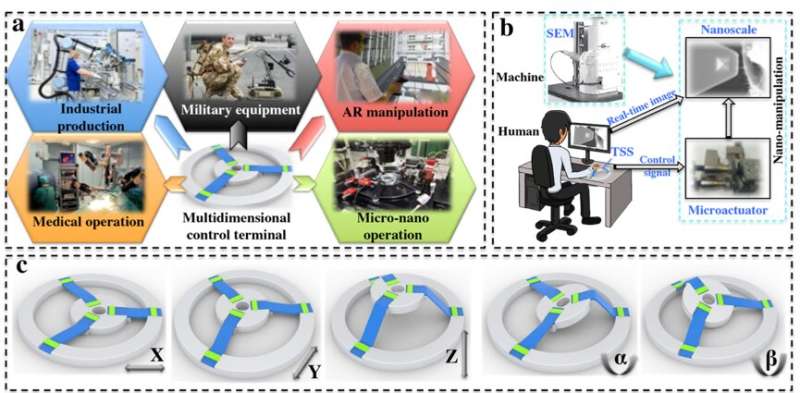April 22, 2019 feature
An ultra-stretchable triboelectric strip sensor (TSS) to control objects in 3-D space

Nanogenerators, technological tools that can convert mechanical or thermal energy into electricity, come in three key designs: piezoelectric, triboelectric and pyroelectric. While piezoelectric and triboelectric nanogenerators can convert mechanical energy into electricity, pyroelectric ones work by harvesting thermal energy.
Over the past few years, tribolectric nanogenerators have become increasingly popular for both energy harvesting and sensing applications. So far, however, their performance in multidimensional information perception and interactive control tasks has been rather disappointing.
Researchers at the National University of Singapore have recently developed sensors for controlling objects in 3D space based on triboelectric nanogenerators. These sensors, presented in a paper published in Nano Energy, are made up of a parallel structure with three symmetric sensor strips fixed on its base and a mobile stage connected to them.
"With the development of science, automation and robotics technologies have penetrated into many aspects of human activities," Tao Chen, one of the researchers who carried out the study, told TechXplore. "Robots are not only widely used in automatic production lines and entertainment fields, but can also have medical, aerospace and military application, as well as many others. However, there are inaccessible, unforeseeable dangerous or unavoidable challenges for humans to interact or perform complex tasks in environments where equipment is maintained in vacuum, undersea, space and nanometer scale, etc."
To enable effective interactions between humans and automated systems, researchers have developed control terminals that can be operated in a variety of ways, such as touch screens, keyboards or rocker structures. In most cases, these control mechanisms are indirect, thus they need complex instruction analyses and calculations to correspond to the movement state of the object to be manipulated.
"In this paper, we present an ultra-stretchable triboelectric strip sensor (TSS) for controlling the attitudes of the object in space," Chen explained. "Our TSS could enhance the performance of robots in a variety of environments, including undersea, space and more."
In their study, Chen and his colleagues used an ultra-stretchable tribolelectric strip as a spatial sensor, which ultimately allows robots to control objects in 3D space. Due to the coupling effect of triboelectrification and electrostatic induction, the length of the strip changes, with the same finger-contacting point generating different signal output ratios from two terminal electrodes (E1 and E2). These electrodes function as the interactive interface for multi-dimensional sensing and control.
"One end of the strip's E1 electrode is fixed, while electrode E2 is movable under tensile stress with respect to E1," Chen said. "The output voltage ratio of the two electrodes (VE2/VE1) is obtained during the contact and separation of finger and silicone rubber with constant distance from E1. Furthermore, the strip is stretched by a certain length, the decrement of voltage ratio is determined as we re-touch the same position (reference point) at a constant distance with respect to the E1 electrode."
As the stretching length of the strip increases, this voltage ratio decreases. The mechanism used by Chen and his colleagues allowed them to measure the extended length of the E2 side of the strip, by touching the reference point that is fixed from E1. In other words, the displacement of their strip while it is stretched, its stretching velocity and the acceleration of the E2 electrode can all be measured with a constant contact frequency.
"The principle of sensor detection used here is mainly to determine the length by comparing the voltage ratio between the two electrodes," Chen said. "Accordingly, the detection mechanism using voltage ratio method avoids the influence of environmental humidity and uneven force. So, this is an effective detection method to avoid instability and interference."
Chen and his colleagues introduced a new object detection method based on a longitudinal movement sensor that uses generated voltage ratios. In their study, they used three self-powered flexible sensors to achieve a 5D positioning projection in space. Their method is simpler and more intuitive than underlying traditional rigid (non-stretchable) structures, yet it also adds space dimensions.
"At present, the operation of nanoscale using handle or key mode is not intuitive," Chen said. "Our approach can be more flexible and intuitive for human-machine interactions on a nano-scale."
In a preliminary demonstration, the researchers used their TSS device as a human-nanomachine terminal to control their nanomanipulator in a scanning electron microscopy (SEM) task. In this task, their device allowed them to operate the carbon nanotubes and successfully complete the extraction of carbon nanotubes.
"The micro-nano manipulation results that we collected confirm the excellent performance of the TSS device on perceptual and control applications, which are relevant to fields such as robotics, VR and IoT," Chen said. "In a follow-up study, we plan to carry out research into the two-hand controller, to achieve more intuitive and convenient human-machine interaction."
More information: Tao Chen et al. Intuitive-augmented human-machine multidimensional nano-manipulation terminal using triboelectric stretchable strip sensors based on minimalist design, Nano Energy (2019). DOI: 10.1016/j.nanoen.2019.03.071
© 2019 Science X Network















